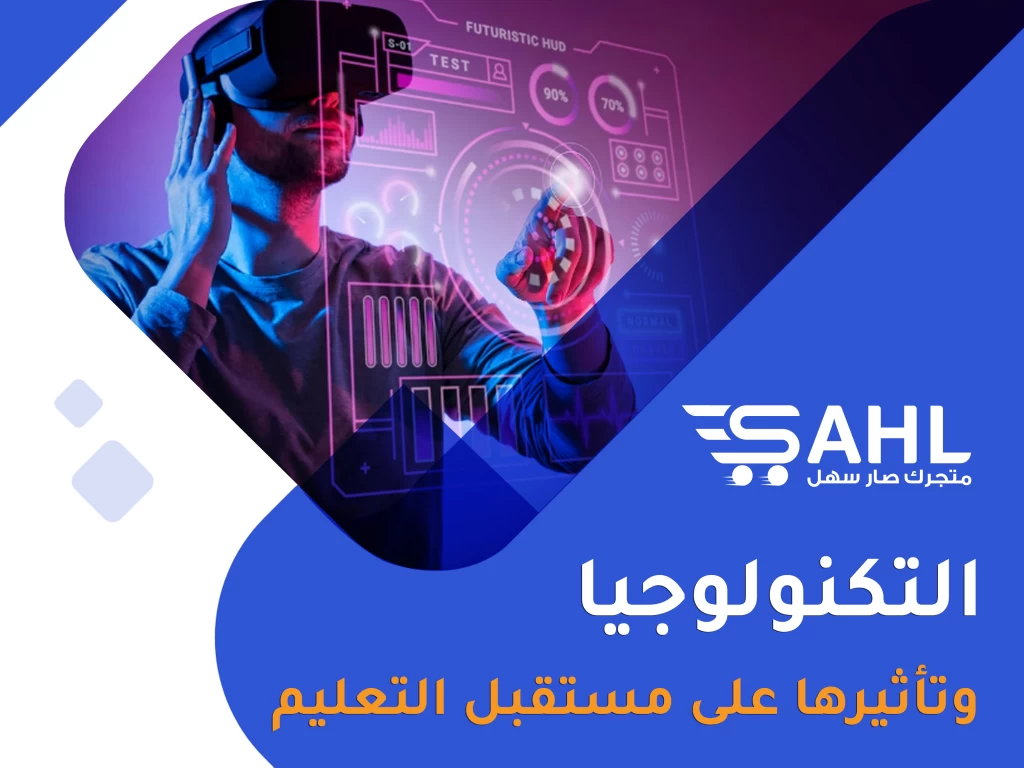Free support 24/7
Free support 24/7

the introduction:
Education is a basic civilizational process that represents the main bridge for progress and achievement in societies. The history of education extends back thousands of years, and has witnessed great developments with the advancement of technology. In this article, we will explore how technology has affected the future of education and the transformations it has brought about.
Section 1: Expanding Access and Communication:
1.1 Distance learning: Distance learning is considered one of the most prominent benefits of technology in the field of education. Through online learning platforms and virtual classroom applications, students around the world can attend lessons and lectures without having to commute to school or university.
1.2 Global communication: Modern technology has been able to connect individuals and teachers from different parts of the world. Teachers and students can exchange ideas and experiences online, which contributes to broadening their educational and cultural horizons.
Section 2: Personalizing and Improving Education:
2.1 Personalized learning: Using analytics and artificial intelligence, teachers can provide personalized learning to each student. These technologies make it possible to analyze models of students' behavior and educational needs and build educational plans that meet the needs of each individual.
2.2 Dynamic educational materials: Educational materials can be easily updated using technology, allowing teachers to provide constantly updated and renewed content. This helps in providing modern and exciting learning experiences to students.
Section 3: Developing students’ skills:
3.1 Critical Thinking Skills: Technology encourages the development of critical thinking skills by providing interactive educational materials needed to solve problems and make decisions.
3.2 Creativity and Innovation: Technology provides tools that enable students to develop creativity and innovation skills, such as application design, programming, and digital arts.
Section 4: Challenges and Concerns:
4.1 Security and Privacy Challenges: Online education must take security and privacy issues seriously. Student data must be protected and the safety of online education must be ensured.
4.2 Balance with traditional education: A balance must be struck between traditional group education and the use of technology in education, as each can effectively complement the other.
Section 5: Future development of education:
5.1 Virtual Reality and Augmented Reality: The future application of technology in education could be related to virtual reality and augmented reality. Virtual reality will allow students to experience interactive learning where they can explore places and events almost realistically. As for augmented reality, it will add interactive elements to the traditional learning environment, making it more attractive.
5.2 Developing assessment and evaluation techniques: Technology can be used to develop assessment and evaluation methods. Teachers can use software and technological tools to accurately track student performance and measure their progress. This can contribute to improving educational quality and guiding students towards achieving educational goals.
Section 16: Towards a sustainable society:
6.1 Promoting sustainable development: Education and technology can contribute to promoting sustainable development by educating individuals about environmental, economic and social issues.
6.2 Contributing to solving global problems: Education and technology can play a big role in helping the world address global challenges such as climate change, poverty and health.
Section 7: Role of Governments and Educational Institutions:
7.1 Educational policies: Governments and educational authorities must develop educational policies that reflect technological transformations and direct them towards achieving educational goals. These policies should include guidance for implementing technology effectively and ensuring the necessary infrastructure is in place.
7.2 Teacher Training: Teachers need to be trained to use technology effectively in education. This will help teachers guide and support students in using technology appropriately and effectively.
Section 8: Future Challenges:
8.1 Equal access: Challenges remain in achieving equal access to education through technology. Digital divides must be combated and everyone can benefit from online education opportunities.
8.2 Ethical Challenges: Technology may pose ethical challenges such as privacy, security, and educational fraud. These challenges must be carefully addressed to ensure the safety and integrity of education.
Section 9: Invitation to take advantage of opportunities:
9.1 Anticipating the future: We must always anticipate the future and monitor technological developments to take advantage of new opportunities and challenges.
Section 10: Potential Challenges and Future Opportunities:
10.1 Emerging Technologies: It can be expected that new technologies will emerge in the future, such as advanced artificial intelligence and deep learning technologies, which will open new horizons for improving education. These technologies may enable the development of more interactive and intelligent educational tools.
10.2 Economic shifts: Educational institutions may experience financial challenges in meeting the costs of educational technology and teacher training. Sustainable financial strategies must be developed to ensure the continuity of this development.
Section 11: Role of individuals:
11.1 Developing self-learning skills: Students, teachers, and education stakeholders must develop self-learning skills and the ability to adapt to ever-changing technology. This helps in getting the most out of education.
11.2 Community Participation: Community participation enhances the quality of education and enhances online learning opportunities. Local and international communities can provide support and motivation for individuals to actively participate in teaching and learning.
Section 12: Celebrating Achievements:
12.1 Celebrating successes: We should celebrate achievements in education and technology, whether small or large, and encourage greater creativity and progress.
12.2 Inspiration for the future: Our successes can be a catalyst for more inspiration and hard work towards
Achieving a positive transformation in the future of education.
Section 13: Future trends in education and technology:
13.1 Lifelong Learning: Lifelong learning will be more important in the future, as individuals will need to constantly develop new skills to keep pace with technological development and changing labor market needs.
13.2 Integration between traditional education and technology: A balance will need to be achieved between traditional education and technology to ensure a comprehensive and balanced educational experience. Schools and universities will be places of learning and social interaction while technology will personalize and enhance this process.
Section 14: Call to Action:
14.1 Activating dialogue: Public dialogue and discussion should be encouraged among all parties involved in education and technology to direct efforts towards improving education.
14.2 Investing in education and research: Governments and institutions should invest in research and development in education and technology to develop new and innovative solutions.
Section 15: The Call to Inspiration:
15.1 A bright future for education: The future of education can be bright and full of possibilities. Thanks to technology, broader and higher quality educational opportunities will be provided to individuals around the world.
15.2 Optimism and preparedness: It is important to have optimism and willingness to face challenges and invest in opportunities in the field of education and technology. If current and future generations do this, the future of education will be brighter and more advanced.
Section 16: Sustaining Change:
16.1 Social Responsibility: Individuals and entities concerned with education and technology must bear their social responsibility with regard to education. Individuals can contribute to the betterment of society by sharing knowledge and experience.
16.2 Promoting inclusivity: Our goal should always be to promote inclusivity in education. We must work to provide equal opportunities for everyone to access education regardless of gender, race, social class or geography.
Section 17: A sustainable approach to education and technology:
17.1 Educational sustainability: Technological development in education must be planned in a sustainable way, thinking about the future impacts of using technology and how to maintain the educational environment.
17.2 International cooperation: International cooperation can play a major role in developing education and technology. Countries and international organizations can share knowledge and experiences to promote education on a global level.
Section 18: Vision for the future:
18.1 Achieving educational excellence: Our vision for the future must be to achieve educational excellence by making the most of technology and innovation.
18.2 Improving individuals’ lives: Education and technology can be a means of improving individuals’ quality of life and increasing their understanding and participation in society.
Section 19: The role of individuals in shaping the future:
19.1 Personal Motivation: No lasting change in the field of education can be achieved without the interaction of individuals. Everyone should be personally motivated to explore and use technology in their learning.
19.2 Sharing ideas and innovation: Individuals must be active participants in the development of educational technology and provide ideas and innovations to improve the educational process.
Section 20: Inspiration for the new generation:
20.1 Motivating youth: We must inspire and encourage new generations to cross boundaries and explore technology creatively to achieve a better future.
20.2 Promoting curiosity: We must encourage the development of a spirit of curiosity among young people and motivate them to research, inquire and explore technology more deeply.
Section 21: Call for Joint Action:
21.1 Integrating Agendas: Individuals and stakeholders in education and technology must integrate their agendas and work together in a collaborative spirit to achieve educational goals.
21.2 Knowledge exchange: Everyone can meet other people and exchange knowledge and experiences in the field of education and technology. This can contribute to accelerating the pace of development.
Section 22: Towards a future built on education and technology:
22.1 Permanent commitment: We must have a perpetual commitment to improving education through technology and continuing to develop methods and tools.
22.2 Achieving balance: We must strive to achieve a balance between technological progress and values and ethics in education, to ensure that technology serves humanity positively.
Conclusion:
In this article, we reviewed the major changes brought about by technology in the field of education and how it affected the future of education. By reviewing the transformations, opportunities and challenges, we renew our call for everyone to work together towards achieving better, more interactive and inclusive education.
Education is the key to a better future, and technology is the means that can enable us to reach this future. But transitions do not come without challenges, so we must be careful and prepared to face them.
With our constant commitment to learning and development, and with the cooperation and dedication of individuals and stakeholders in education and technology, we can shape a future built on education and technology that serves everyone. Let us continue to work together to achieve positive transformation in education and create new opportunities for current and future generations.

Flash sales are not just a temporary marketing tool. They are a smart tool to quickly drive sales and increase engagement in your store

تعرف على الطريقة الذكية اللي تخليك تستفيد من تجارب عملاءك السابقين في تسويق منتجاتك الجديدة وزيادة المبيعات
You can create your store easily